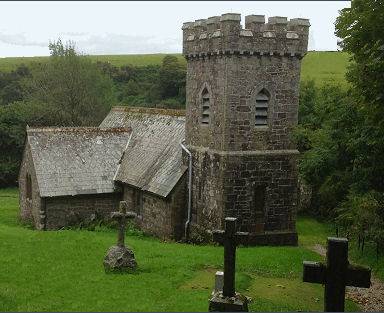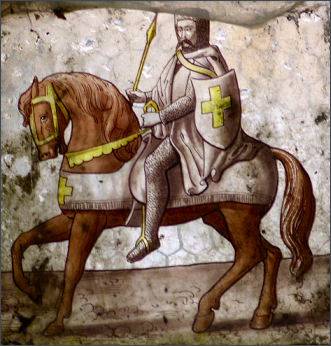Temple
OS Grid ref:- SX0676
The small remote hamlet of Temple is situated on Bodmin Moor between Bodmin and Launceston, and lies within the parish of Blisland, it is bounded on the east by the village of St Neot, and to the south by Warleggan and Cardinham. The village derives its name from the twelfth century hospice founded by Knights Templars. The earliest mention of the site is in the Domesday Book of 1086 when it was recorded as Nietstou. On the outskirts of the hamlet is a small granite outcrop known as 'Temple Tor'.
Temple Church
 A hospice was constructed by the Knights Templar on land owned by them at Temple to provide refuge for pilgrims and travellers, en route to the Holy Land. The Knights Templar, in their distinctive white mantles marked with a red cross, were among the most skilled fighting units of the Crusades.
A hospice was constructed by the Knights Templar on land owned by them at Temple to provide refuge for pilgrims and travellers, en route to the Holy Land. The Knights Templar, in their distinctive white mantles marked with a red cross, were among the most skilled fighting units of the Crusades.
 In 1150 the Lordship of the manor of Trebeigh (Trebythe) was granted to the Order of Templars by King Stephen. While it is known "that from 1259 the Master was patron of the neighbouring parish church of St. Ive, it is not certain whether the Templars were concerned with its building". In 1185, the Templars' estate here was described as 'one land on Fawimore', Fowey Moor was the name once used for Bodmin Moor.
In 1150 the Lordship of the manor of Trebeigh (Trebythe) was granted to the Order of Templars by King Stephen. While it is known "that from 1259 the Master was patron of the neighbouring parish church of St. Ive, it is not certain whether the Templars were concerned with its building". In 1185, the Templars' estate here was described as 'one land on Fawimore', Fowey Moor was the name once used for Bodmin Moor.
The order was formally disbanded by Pope Clement V in 1312, when the the Knights Templars property, including the hospice at Bodmin Moor were transferred into the hands of the Knights Hospitallers (in 1314), who held it until the religious houses were suppressed by order of King Henry VIII at the time of the Reformation. In 1934, the parish of Temple was incorporated into Blisland parish.
After the suppression of the Knights Templar, a church was built, dedicated to St Catherine of Alexandria, which occupied the site of the earlier Templar chapel.
 It became famous as a place where marriages could be performed without banns or licence (similar to Gretna Green until the early twentieth century). Writer John Norden, visiting the church in 1584, described it as "a lawless church where many bad marriages are consummated ad where are wonte to be buried such as wrought violent death upon themselves ". This was to ended in 1744 when the church first came under episcopal jurisdiction. By the mid nineteenth century, the building stood in ruins with an ash tree growing in the floor. The church was rebuilt by Silvanus Trevail, the most prominent Cornish architect of the nineteenth century, in 1883.
It became famous as a place where marriages could be performed without banns or licence (similar to Gretna Green until the early twentieth century). Writer John Norden, visiting the church in 1584, described it as "a lawless church where many bad marriages are consummated ad where are wonte to be buried such as wrought violent death upon themselves ". This was to ended in 1744 when the church first came under episcopal jurisdiction. By the mid nineteenth century, the building stood in ruins with an ash tree growing in the floor. The church was rebuilt by Silvanus Trevail, the most prominent Cornish architect of the nineteenth century, in 1883.
The church still contains several references to its links with the Knights Templar, including a cross pattée in the east window and a depiction of a mounted knight who is bearing a shield emblazed with a cross (pictured left) in the north window of the church tower.
To the right of the church porch stands a small outhouse in which several old crosses and gravestones have been built into the fabric of its wall. These items were discovered when the church was restored. One of these crosses is an incised Patriarchal Cross, in AD 451 the Archbishop of Jerusalem was made a Patriarch and its use was later granted to the Knights Templar. The Duke of Lorraine, Godefroy Boullion used the Patriarchal Cross on his standard during the capture of Jerusalem which lead to its alternative name - the Cross of Lorraine.
The base of the original Norman font is embedded into the inner wall over the church door, which was unearthed after the font had been restored. The silver communion cup and plate, dated 1577, which had been taken to nearby Blisland for safekeeping before 1764, were eventually returned.
Towns and Villages of Cornwall